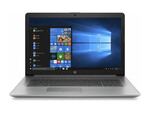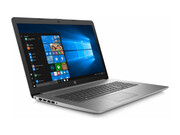HP 470 G7, i5-10210U, Radeon 530
Specifications

Price comparison
Reviews for the HP 470 G7, i5-10210U, Radeon 530
Source: Laptop Media
 Archive.org version
Archive.org versionAdditionally, the device is pretty flexible on the upgradability, with an M.2 NVMe drive support, dual-channel memory, 2.5″ SATA drive bay, and an SD card reader on the outside. However, we are puzzled why would HP go for a chassis with such poor quality. Okay, we might have overexaggerated, but the entire body is made out of plastic and is certainly not providing any premium feel, whatsoever.
Single Review, online available, Very Long, Date: 05/15/2020
Comment
AMD Radeon 530: Entry class dedicated graphics card with 320 or 384 shaders (depending on the used chip) and DDR3 or GDDR5 graphics memory (both with a 64 Bit bus). Both chips are used for a few years, e.g. even starting with the Radeon 8590M (28nm GCN).
Modern games should be playable with these graphics cards at low settings and resolutions. Casual gamers may be happy with these cards.
» Further information can be found in our Comparison of Mobile Graphics Cards and the corresponding Benchmark List.
i5-10210U: Comet Lake based low power quad-core processor (technically identical to Whiskey Lake and still produced in 14nm++). The CPU cores can clock between 1.6 and 4.2 GHz (all 4 cores 3.9 GHz max.) with HyperThreading (8 threads). The integrated memory controller supports LPDDR4-2933 and using cTDP up/down the performance can be adjusted by the OEM (10 - 25 Watt possible, 15W default). Compared to the faster i5-10510U, the level 3 cache was reduced from 8 to 6 MB.» Further information can be found in our Comparison of Mobile Processsors.




